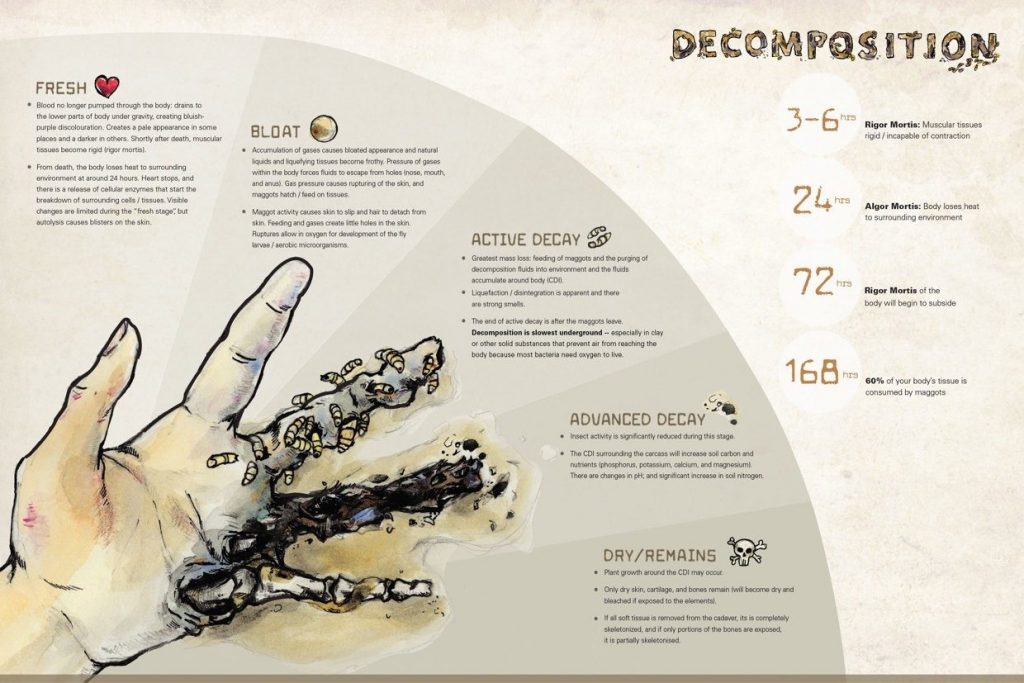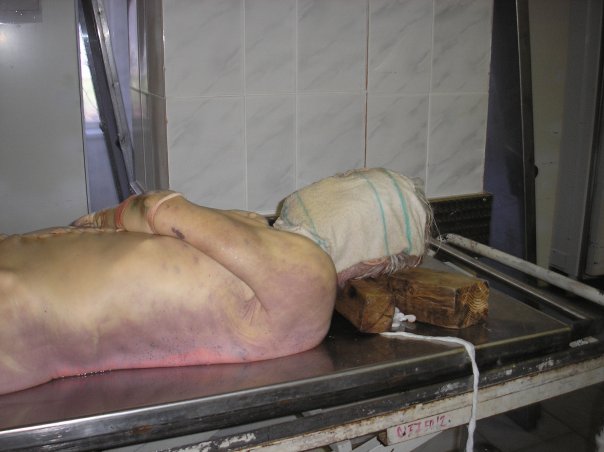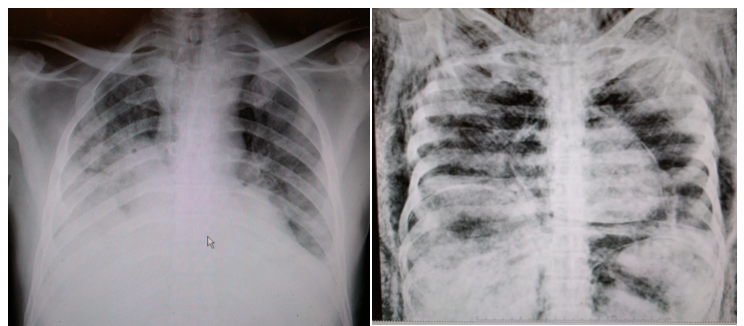I have worked at the morgue for a little over a month and I can say with certainty that the worst part of my job is getting hands-on with head traumas and decomposed bodies.
I will get to head traumas another time. Right now I’d like to focus on decomposition because while disgusting, it’s a truly fascinating process from a physiological standpoint. Before I dive into the specifics, here’s a bit of background in case you’re just tuning in.
At the morgue, it is my job to x-ray every decomposed body that comes in, regardless of how the person died. As I stated in a previous post, I’m responsible for x-raying all gunshot wounds, motor vehicle accidents, and child deaths, without question. I’ll read reports from falls and suicides. Depending on the nature of the event, we may or may not need to x-ray them. Decomposed bodies always get x-rayed without question.
 Let’s talk a bit about decomposition—yay! I should note that I will be showing some images that might be unsettling or upsetting. View at your own risk.
Let’s talk a bit about decomposition—yay! I should note that I will be showing some images that might be unsettling or upsetting. View at your own risk.
When you die, your heart stops beating and your body’s cells stop receiving oxygen. Typically brain cells are the first to die, while bone and skin cells can survive for several days. Blood begins to drain from vessels and pools in the lower-lying portion of the body. So if a person dies lying on their left side, that side will appear darker while the right side appears more pale. This is called livor mortis, or lividity.

{source}
Side note: There are several “mortis” stages that a body goes through. The ones not covered in great detail here are pallor mortis, which is a pale or ashy appearance, and algor mortis, which is a change in body temperature. Algor literally translates to coldness.
Roughly three hours after death, rigor mortis sets in. Rigor mortis is simply a stiffening of muscles. In a living body, calcium ions flow into muscle cells and promote attachment between two muscle fibers, actin and myosin. Once attached, this causes the muscle to contract. A muscle remains in this state until ATP arrives to pump the calcium out of the cell. However, in a dead body, no oxygen means no ATP. Skeletal muscles will remain contracted until the muscles start to decompose.
Fun facts about rigor mortis:
- It’s Latin for “stiffness of death”
- Facial muscles stiffen before larger muscles
- It can start anywhere from 10 minutes to several hours following death and can last up to three days (it’s greatly affected by temperature)
As the cells within a body begin to die, there is nothing maintaining their structural integrity, and so their membranes begin to break. As they do, they release enzymes that begin eating the cell from the inside out. This is usually referred to as autolysis, which means self-digestion. While this is happening, microorganisms and bacteria produce very unpleasant odors called putrefaction.
Additionally, the leaked enzymes produce many gases, including hydrogen sulfide, carbon dioxide, and methane. The pressure from these gases cause the body to bloat, which is the second phase of decomposition. The pressure can become so intense that some bodies can actually double in size. Bloat usually occurs around five days after death, according to an article I read.

{YouTube}
Fun fact: Tongues and scrotums aren’t immune to bloating. Bloat is most common in the face, abdomen, and in males, the scrotum. One of the only good things about working with decomposed bodies is that we don’t have to open the body bag. However, this can make positioning a body for an x-ray more challenging since landmarks aren’t easily identifiable. One of the ways we “get our bearings” is to feel for facial landmarks. Usually we go for the nose and eyes, but depending on the stage of decay, sometimes the tongue is a dead (heh, pun) giveaway. The tongue expands so much that it protrudes from the mouth acting almost like a handle.
The tech I trained with opened every decomp bag so I could see the process in its various stages. Disgusted, I still looked because my sense of curiosity is a glutton for punishment. Before opening the bag, she would say, “Here, feel this.” Completely at a loss for what body part my hand might be touching, I’d ask her what it was. “That’s his scrotum.” I skeptically pulled my hand away because it felt more like a knee or elbow than soft tissue. But I was proven wrong when she opened the bag. The scrotum had such a buildup of pressure due to the gases within the body that it had no choice but to expand to double its original size.
Although a great way to startle a first-week forensic tech, this can actually be dangerous. The buildup of pressure combined with the loss of integrity of the decomposing skin could cause the body to rupture. So think twice before you go poking around decomposed bodies, okay?

{YouTube}
By this point, the combination of feeding maggots, purged fluids, and cellular breakdown means the body has entered active decay. During this time, liquefaction of tissues becomes more visually apparent and extremely strong odors exist. If you think a fresh dead body smells bad, you’re gravely mistaken. I don’t know how to begin to describe the smell of a decomposing body.
One article attempted to do so, stating:
- Cadaverine and putrescine smell like rotting flesh
- Skatole has a strong feces odor
- Indole has a musty, mothball-like smell
- Hydrogen sulfide smells like rotten eggs
- Methanethiol smells like rotting cabbage
- Dimethyl disulfide and trisfulfide have a foul, garlic-like odor
Another article went the less scientific route, asking 20 people to describe the smell of death. I think this one is the most accurate:
“Rotten eggs, feces, and a used toilet left out for a month x 1,000.”
Working with bodies in active decay is very difficult. The vicious attack on one’s nose is frustrating enough, but the bodies are slippery too. The pressure from the gases forces fluids within the body to escape through open orifices, like the mouth, nose, anus, etc. And since we’re working through the body bag. The material of the bag paired with the slippery goop makes for a very frustrated x-ray tech.
Toward the end of active decay, when all of the body’s soft tissue has decomposed, hair, bones, and cartilage remain. Although decomposition begins almost immediately following death, it can take up to one year for a body to completely decompose to a skeleton. From there, it can take another eight to 12 years to decompose a skeleton. It depends on a variety of factors. Is the body buried in a dirt grave? Was it buried in a coffin? Was it embalmed? If not buried, what’s the temperature and environment like?
After active decay, the body enters something called butyric fermentation. While I’m not certain this is an official stage of decomposition, it’s something that occurs once the body has dried out and butyric acid accumulates. Butyric acid is present in human vomit, so you can imagine how awesome this stage smells. During this “stage,” the skin turns leathery and marks the transition from active decay to dry decay. In dry decay, roughly 50 days to one year after death, the body is almost completely dry and may actually mummify depending on environmental conditions.
At the morgue, I have worked with bodies in every stage of decay. None were pleasant, but I suppose the beginning stage is the easiest. When it comes to working with dead people, I prefer those that are still exhibiting rigor mortis. In a later post, you’ll see how I contradict that statement, but for now I stand by it. Without rigor mortis, bodies move too easily and seem too life-like. It interferes with the mental barrier I’ve constructed so I can do my job without puking and/or crying.
I debated whether or not I would show you this. I was given permission to use x-rays for education purposes at school, so I felt conflicted about posting anything here. I don’t think I’ll make a habit of this, but I really wanted you to see the differences between an x-ray of someone who had just died compared to that of someone who’s actively decaying.
Normal on the left and decay on the right.
Can you see the difference? Isn’t it interesting?! Because we work through the bags, I’m never quite sure what stage of decomposition the body is in. But the x-rays always show it. Now, an x-ray won’t tell you down to the day of decomposition the body is in, but it can give you a fairly good idea of whether it’s in the beginning stage or active stage. I think it’s fascinating. Hopefully, as I learn more about pathology and identifying different types on x-rays, I’ll be able to notice even the most subtle of decomposition markers. #XrayGoals

